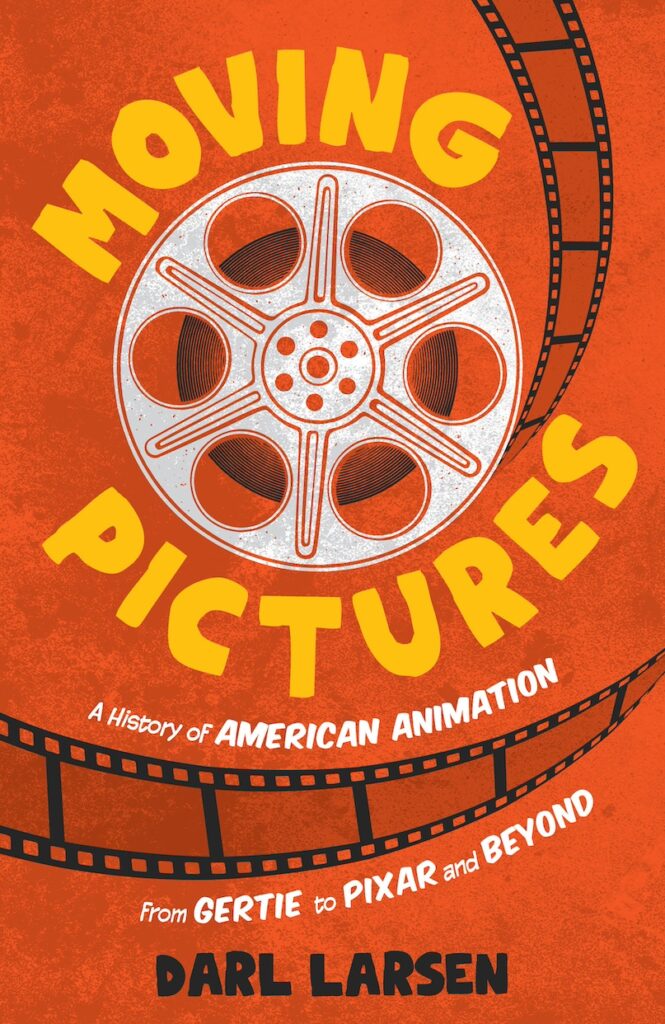Beyond Disney: Here’s a Book for Those Who Consider That Name the End-All and Be-All of Animation
Treating Disney as ‘a categorical imperative,’ the author explores the beginnings of film animation and digs into the nooks-and-crannies of its trajectory, business practices, and influence on culture.

‘Moving Pictures: A History of American Animation From Gertie to Pixar and Beyond’
By Darl Larsen
Rowman & Littlefield
A professor of film and animation studies at Brigham Young University, Darl Larsen found his metier through divine intervention. While leafing through a hymnal at an early age, a vision appeared in its pages: a figure with a bow shooting an arrow at a distant target. This scenario wasn’t, in actual fact, heaven-sent: A budding artist — bored, presumably, with the devotional lesson of the day — had transformed the hymnal into a forum for cartooning. “A quick thumb-flip of dog eared pages,” Mr. Larsen writes, “sent the arrow along its herky-jerky path.”
Professor Larsen is on a mission to enlighten a benighted populace or, at least, the portion of our culture for whom the name “Disney” is the end-all and be-all of animation: “Walt Disney was no bigger or better than competitors of the 1920s and well behind several.” Treating Disney as “a categorical imperative,” Mr. Larsen explores the beginnings of film animation and digs into the nooks-and-crannies of its trajectory, business practices, and influence on culture. He brings with him a hands-on knowledge of animating processes and, with that, an appreciative critical eye.
In an early chapter, for instance, Mr. Larsen takes to task a film historian, Leonard Maltin, for his dismissal of the early efforts of animator Paul Terry. Citing Mr. Maltin’s opinion that Terry’s “Aesop’s Fables” cartoons were run-of-the-mill, our interlocutor cites specific moments in which they exhibit “some care and art.” Cast your eye on “A Day Off” (1928) — or, rather, the latter half of its 11-minute run — and you’ll likely agree, as Farmer Alfalfa galumphs his way through a Surrealistic landscape populated by shape-shifting bathing beauties.
Still, Mr. Larsen esteems Terry primarily as a consummate businessman “keeping his product predictable, dependable and affordable — the exhibitor’s holy trinity.” The marketplace has its own wiles, and when sound technology came in, Terry was resistant before eventually producing the first sound cartoon, “Dinner Time” (1928). The trade publications extolled it as a commercial success: “Paul Terry has done it again.” Two months later “Steamboat Willie” (1928) entered theaters and introduced the world to Mickey Mouse. Things changed.

Disney, as we all know, went on to bigger things and, in the process, was forever on the verge of losing his shirt. Mr. Larsen’s portrait of the man has Disney forever trying to catch up with an abiding perfectionism. “Snow White and the Seven Dwarfs” (1937) was a huge gamble: “With a cartoon feature, there were no certainties, no built-in audience, no distribution models, no proven marketing strategies.” The film was a box office success, clearing the way for future feature length cartoons.
Which Disney, at least initially, couldn’t finagle. “Pinocchio” (1940) received critical accolades, but sub-“Snow White” receipts. The box office failure of “Fantasia” (1940) forced the company’s hand to cut studio operations by 20 percent. As for “Bambi” (1942): It didn’t break even and was, to many a critic, a sign of Disney’s capitulation to the “cute and pretty.” Cultural commissars of the time pegged him as a goner. Predictions, being a dime a dozen, don’t always pan out. Although it would be some time before the bottom line was written in black, Disney soldiered on.
Mr. Larsen is a deceptively pointed writer, peppering a sometimes overcomplicated run of movers-and-shakers with surprising opinions and insights. Citing Disney’s doggedness, particularly during the World War II, Mr. Larsen wonders if he didn’t set a model for filmmakers like Akira Kurosawa, Luis Buñuel, Satyajit Ray, and any New Waver you could care to name: “And to add fuel to this reckless fire … Disney was creating these ‘new’ films not primarily via the commercial market but with the help of funds from the government.” Six degrees of separation from Donald Duck is … Jean-Luc Godard?
Mr. Larsen is on surer footing when casting a critical eye on the qualities of animation itself. His discussions of Tex Avery, both about the evident mastery and aesthetic limitations of the cartoons, are particularly enlightening. Citing the five-episode run of “Screwy Squirrel,” Mr. Larsen points to the self-reflexive nature of Avery’s aesthetic: “Again and again, the illusion of an immutable diegetic realist is undercut.” Which goes some way in explaining why Avery’s films are brilliantly hyperkinetic when seen on a piecemeal basis; over the long haul they’re shrill and exhausting.
The strongest portions of Mr. Larsen’s book detail the impact of World War II on the animation industry and the changes it underwent upon the arrival of television. From the 1960s onward, the author sprints his way to the here-and-now, breathlessly listing a gaggle of names, titles, takeovers, mergers, and how the waters of art and commerce have been muddied by streaming services: “‘Revenues’ become much harder to track; films that ‘make money’ are much harder to identify.” As it is, Mr. Larsen’s heart belongs to pre-1950s animation, the lacunae of which he illuminates to impressive effect.

